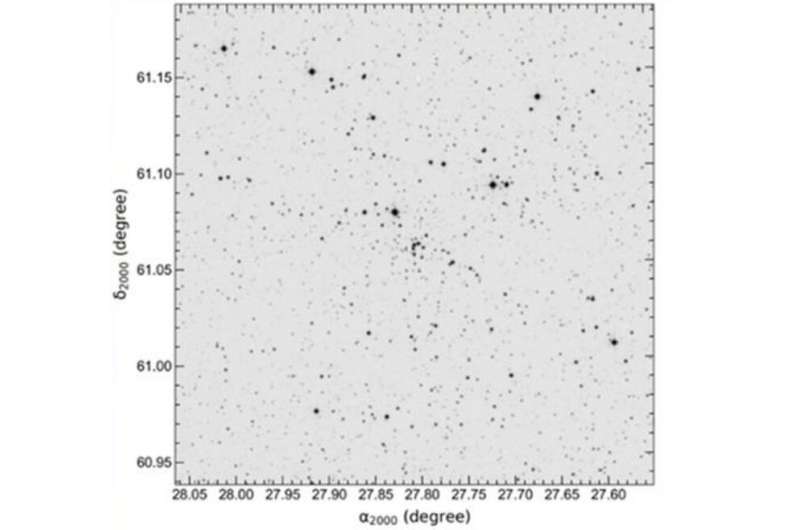
Using ESA’s Gaia satellite, Turkish astronomers from the Istanbul University have explored a Galactic open cluster known as Berkeley 6. Results of the study, published June 27 in the Bitlis Eren University Journal of Science, shed more light on the properties and nature of this cluster.
Open clusters (OCs), formed from the same giant molecular cloud, are groups of stars loosely gravitationally bound to each other. So far, more than 1,000 of them have been discovered in the Milky Way, and scientists are still looking for more, hoping to find a variety of these stellar groupings. Expanding the list of known galactic open clusters and studying them in detail could be crucial for improving our understanding of the formation and evolution of our galaxy.
Located between 7,900 and 10,000 light years away from the Earth, Berkeley 6 (or Be 6 for short) is a Galactic open cluster with a core radius of 0.54 arcminutes and reddening at a level of 0.9 mag. The cluster is estimated to be between 32 and 400 million years old.
Given that many parameters of Berkeley 6 remain unknown or uncertain, astronomers Seliz Koc and Talar Yontan decided to investigate this poorly-studied cluster with Gaia. By analyzing the third photometric, spectroscopic, and astrometric data release (DR3) from Gaia, they managed to get more insights into the properties of this OC.
“In this study, we presented structural and astrophysical parameters of the Be 6 open cluster by using Gaia DR3 photometric and astrometric data,” the researchers wrote in the paper.
Gaia DR3 provides high quality astrometric and photometric data on more than 1.5 billion celestial objects. Based on this catalog, Koc and Yontan obtained 23,139 stars with magnitudes ranging from 7 to 22 mag and then calculated the membership probabilities of stars located in the region of Berkeley 6.
In result, the authors of the paper identified 119 physical member stars for this cluster and found a central stellar density for this OC of approximately 38.84 stars per square arcminute. The mean proper motion Berkeley 6 was measured to be -0.894 and -0.533, in right ascension and declination, respectively.
Furthermore, the study found that Berkeley 6 is about 350 million years old, has a limiting radius of some 12.45 light years, and color excess of 0.918 mag. The results indicate that the cluster has a solar metallicity.
When it comes to the distance estimates, the astronomers obtained parallax and isochrone distances for Berkeley 6, they were measured to be 10,000 and 8,560 light years. Although there is a significant difference of about between these two results, the researchers noted that the two distance values are compatible within the errors. The galactocentric distance for the cluster was measured to be 32,300 light years.
More information:
Seliz KOÇ et al, Astrophysical Parameters of the Open Cluster Berkeley 6, Bitlis Eren Üniversitesi Fen Bilimleri Dergisi (2023). DOI: 10.17798/bitlisfen.1213059. On arXiv: arxiv.org/abs/2306.15367
Journal information:
arXiv
© 2023 Science X Network
Open cluster Berkeley 6 investigated in detail (2023, July 5)
retrieved 27 September 2023
from https://phys.org/news/2023-07-cluster-berkeley.html
part may be reproduced without the written permission. The content is provided for information purposes only.